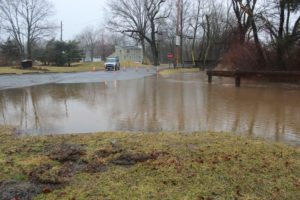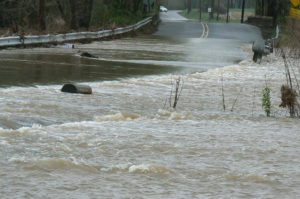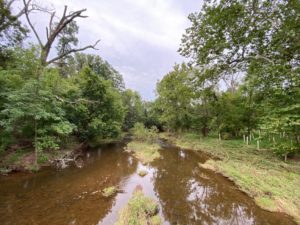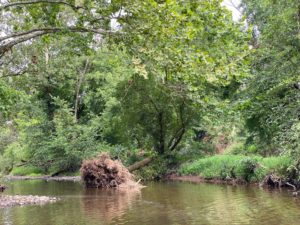 The changing climate and continual creep of development across the Garden State are a double whammy that portends more flood damage to homes and businesses unless our state and local governments take bold action. The physics is pretty simple: a warmer atmosphere creates more evaporation and more precipitation during storms. As hard surfaces like asphalt and concrete spread, there is less room for water to percolate into the ground, causing more runoff.
The changing climate and continual creep of development across the Garden State are a double whammy that portends more flood damage to homes and businesses unless our state and local governments take bold action. The physics is pretty simple: a warmer atmosphere creates more evaporation and more precipitation during storms. As hard surfaces like asphalt and concrete spread, there is less room for water to percolate into the ground, causing more runoff.
These major storms – Ida, Henri, Irene, Sandy – displaced millions of people and exposed many to the health hazards of floodwaters contaminated with fecal matter, industrial toxins, and other pollutants from the overwhelmed storm and sewage systems.
According to the Rutgers NJ Weather Network, July 2021 provided a never-ending cascade of weather events, including a tropical storm, a record-tying number of tornadoes, large hail, flash floods, and more. The statewide average precipitation of 7.59” was 2.88” above the 1991–2020 normal and ranked 8th wettest of all Julys back dating to 1895. It was the wettest July since 1975 and second wettest in almost 50 years.
Our state and local leaders should adopt a four-part strategy to protect our state from the storms that most assuredly will continue to come with greater frequency and intensity.
 First, strengthen protections against development near streams, rivers, and coastlines. As the saying goes, when you are in a hole, stop digging. Allowing more homes and businesses to be built near waterbodies will just lead to more costly damages from flooding. Unfortunately, in 2016, regulations implementing the Flood Hazard Area Control Act were weakened to ease restrictions on such developments. Our officials should reverse those moves and strengthen protections against building near water bodies.
First, strengthen protections against development near streams, rivers, and coastlines. As the saying goes, when you are in a hole, stop digging. Allowing more homes and businesses to be built near waterbodies will just lead to more costly damages from flooding. Unfortunately, in 2016, regulations implementing the Flood Hazard Area Control Act were weakened to ease restrictions on such developments. Our officials should reverse those moves and strengthen protections against building near water bodies.
Second, remove imperiled homes and businesses from harm’s way. According to a January 2017 report prepared for New Jersey Realtors, nearly 300,000 land parcels are located within the 100-year floodplain in New Jersey’s nine eastern counties. Since Superstorm Sandy, New Jersey has used state and federal funding to purchase and demolish hundreds of flood prone homes from willing sellers in 11 towns. The state should embrace this “Blue Acres” program to protect people from flooding while providing additional land to soak up floodwaters.
 Third, require developers to build smarter. Every time we cover the earth with hard surfaces that are impervious to water, we cause our flooding problems to worsen. But there are ways to mitigate this problem by requiring businesses and municipalities to install “green infrastructure” systems like rain gardens, and cisterns to catch stormwater runoff generated by construction projects, and use the water or allow it to percolate gradually into the ground. Our state’s stormwater regulations require such actions to some degree, but only on large new developments. These measures must be strengthened to protect our communities from the unintended consequences of construction up stream from where people live and work.
Third, require developers to build smarter. Every time we cover the earth with hard surfaces that are impervious to water, we cause our flooding problems to worsen. But there are ways to mitigate this problem by requiring businesses and municipalities to install “green infrastructure” systems like rain gardens, and cisterns to catch stormwater runoff generated by construction projects, and use the water or allow it to percolate gradually into the ground. Our state’s stormwater regulations require such actions to some degree, but only on large new developments. These measures must be strengthened to protect our communities from the unintended consequences of construction up stream from where people live and work.
Fourth, retrofit older developments to address flooding. Much of our state was developed long before there were concerns about runoff or flooding. To really tackle our flooding problems, we must address developments built before these regulations were adopted.
 We need bold action to reduce our emissions of greenhouse gases so that our state does its part in preventing the worst extremes of climate change. And our state and local leaders must prepare our state for the inevitable extreme weather that will bring more flooding.
We need bold action to reduce our emissions of greenhouse gases so that our state does its part in preventing the worst extremes of climate change. And our state and local leaders must prepare our state for the inevitable extreme weather that will bring more flooding.

